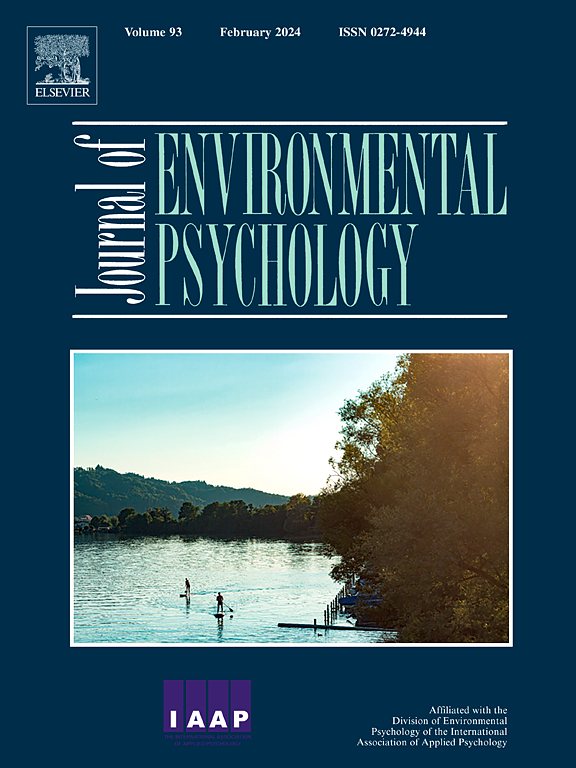区域标志(色带)对空间导航性别差异的影响:方向感的调节作用
IF 7
1区 心理学
Q1 ENVIRONMENTAL STUDIES
引用次数: 0
摘要
虽然研究已经广泛研究了全球和地方地标如何影响空间导航中的性别差异,但区域地标的影响——在复杂环境中划分不同区域的视觉特征(如医院的颜色区)——仍未被探索。这些地标提供一般的位置信息,但既不能提供局部地标的精确位置信息,也不能提供全局地标的方位信息。我们研究了区域地标如何影响导航和后续决策的性别差异,并检查这些影响是否被自我报告的方向感(SOD)所调节。参与者(N = 84)在有或没有区域地标的虚拟环境中完成了不同难度的寻路任务,随后是基于价值的决策任务,这取决于前一个寻路任务的学习结果。我们发现SOD调节了区域标志对性别差异的影响。在存在区域标志的路线学习任务中,低sod的男性表现优于低sod的女性,而高sod的女性表现与高sod的男性相同或更好。在需要认知映射的任务中,SOD的作用消失;女性的表现与男性相当,但没有区域性标志的女性表现明显更差。此外,当控制基于以往经验的决策一致性时,高sod女性在区域地标上更冒险。这些发现有助于调和文献中关于地标利用和决策性别差异的不同结果,并强调了考虑环境因素与空间能力之间的相互作用对于理解空间导航性别差异的重要性。我们的研究结果也对复杂建筑的助航设计具有实际意义。本文章由计算机程序翻译,如有差异,请以英文原文为准。
The influence of regional landmarks (color zones) on sex differences in spatial navigation: The moderating role of sense of direction
While research has extensively examined how global and local landmarks influence sex differences in spatial navigation, the effects of regional landmarks—visual features that demarcate different sections within complex environments (like color zones in hospitals)—remain unexplored. These landmarks provide general location information but offer neither the precise positional information of local landmarks nor the orientational information of global landmarks. We investigate how regional landmarks affect sex differences in navigation and subsequent decision-making, examining whether these effects are moderated by self-reported sense of direction (SOD). Participants (N = 84) completed wayfinding tasks of varied difficulty in virtual environments with or without regional landmarks, followed by value-based decision-making tasks that depends on the learning outcome of the previous wayfinding tasks. We find that regional landmarks' effects on sex differences are moderated by SOD. In route-learning tasks with regional landmarks present, low-SOD men outperformed low-SOD women, whereas high-SOD women performed equally or better than high-SOD men. In task that required cognitive mapping, the SOD effect disappeared; women performed comparably to men with regional landmarks present but performed significantly worse without them. Additionally, when controlling for the consistency in basing decision-making on previous experiences, high-SOD women were more risk-taking with regional landmarks. These findings help reconcile mixed results in the literature on sex differences in landmark utilization and decision-making, and highlight the importance of considering the interaction between environmental factors and spatial ability in understanding the sex differences in spatial navigation. Our results also have practical implications for designing navigational aids in complex buildings.
求助全文
通过发布文献求助,成功后即可免费获取论文全文。
去求助
来源期刊

Journal of Environmental Psychology
Multiple-
CiteScore
10.60
自引率
8.70%
发文量
140
审稿时长
62 days
期刊介绍:
The Journal of Environmental Psychology is the premier journal in the field, serving individuals in a wide range of disciplines who have an interest in the scientific study of the transactions and interrelationships between people and their surroundings (including built, social, natural and virtual environments, the use and abuse of nature and natural resources, and sustainability-related behavior). The journal publishes internationally contributed empirical studies and reviews of research on these topics that advance new insights. As an important forum for the field, the journal publishes some of the most influential papers in the discipline that reflect the scientific development of environmental psychology. Contributions on theoretical, methodological, and practical aspects of all human-environment interactions are welcome, along with innovative or interdisciplinary approaches that have a psychological emphasis. Research areas include: •Psychological and behavioral aspects of people and nature •Cognitive mapping, spatial cognition and wayfinding •Ecological consequences of human actions •Theories of place, place attachment, and place identity •Environmental risks and hazards: perception, behavior, and management •Perception and evaluation of buildings and natural landscapes •Effects of physical and natural settings on human cognition and health •Theories of proenvironmental behavior, norms, attitudes, and personality •Psychology of sustainability and climate change •Psychological aspects of resource management and crises •Social use of space: crowding, privacy, territoriality, personal space •Design of, and experiences related to, the physical aspects of workplaces, schools, residences, public buildings and public space
 求助内容:
求助内容: 应助结果提醒方式:
应助结果提醒方式:


